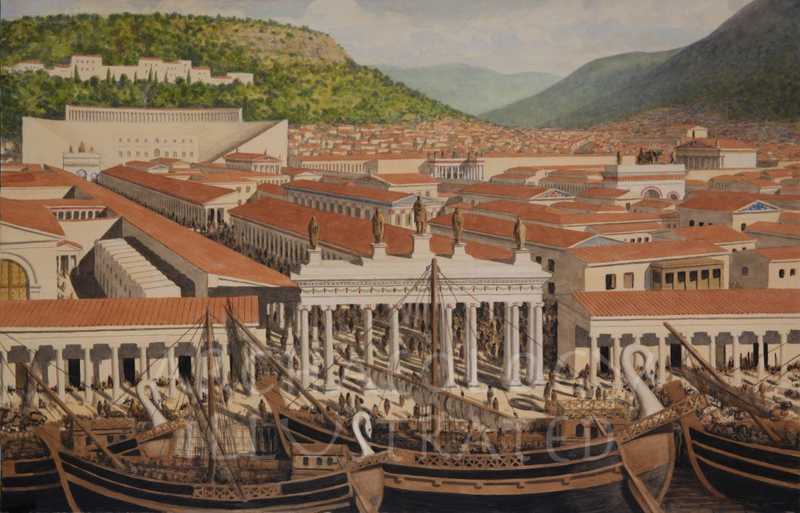The full chronology of Ephesus' long history which witnessed many major political and socioeconomic events.
B.C.
8200 – Evidence of earliest settlement found in excavations at Çukuriçi Höyük, a tumulus in the southeast of Ephesus.
5000-3000 – Prehistoric settlement discovered in excavations on Hill of Ayasuluk.
1400 – Mycanaean findings located in Ephesus area.
1345-1315 – Region is devastated in war between Hittite king, Mursili II, and King Uhhaziti of Arzawa and Apasa.
1000 – According to legend, Androclus, son of King Codrus of Athens, founds Ephesus at foot of Mt Pion.
645 – Cimmerians invade region under command of Lygadamis.
600s – Elegiac poet, Callinus, lives in Ephesus.
560 – Lydian king, Croesus, begins building Archaic Temple of Artemis during his rule over Ephesus.
546 – Median general, Harpagus, captures Ephesus.
550-500 – Ephesus comes under Persion sovereignty.
466 – Ephesus joins Delian League, or First Athenian Alliance.
431-404 – Ephesus sides with Spartans and Persians to fight Against Athens in Peloponnesian War.
356 – Temple of Artemis is (according to legend) burned down by Herostratus, a lunatic.
334 – Alexander the Great enters Ephesus and offers to finance Temple of Artemis; Ephesians politely decline, claiming it inappropriate for one god to build a temple to another.
319-281 – Sovereign powers in Ephesus change hands during Wars of the Dadiochi,; city is rebuilt by Lysimachus heralds beginning of Seleucid period.
260 – Ephesus captured by Philadelphus, second king of Ptolemaic dynasty.
195-190 – Hannibal flees to court of Antiochus in Ephesus.
191 – City is besieged by Romans following naval defeat of Polyxenidas, governor of Ephesus under Antiochus.
188 – Under peace of Apamea, Ephesus becomes part of Kingdom of Pergamon.
133 – King Attalus III of Pergamon bequeaths kingdom to Roman Republic; Province of Asia is founded.
100 – Greek geographer, Artemidorus, lives in Ephesus.
88 – Ephesus sides with Mithridates of Pontus; all Romans in the city are slaughtered.
86 – City is penalized by Roman commander, Lucius Cornelius Sulla.
73 – L.Licinius Lucullus becomes governor of Ephesus.
44 – Two of Ceasar’s assassins, M. Junius Brutus and G. Cassius Longinus, flee to Ephesus.
41 – Mark Antony comes to Ephesus with Cleopatra; Cleopatra’s sister, Arsinoe IV, is killed after taking refuge in Artemision (Temple of Artemis).
31 – Ephesus becomes base for Mark Antony prior to dispute with Octavian.
29 – Province of Asia reorganized by Octavian; Ephesus takes over from Pergamon as capital of Asia and city is furnished with impressive monuments. Strabo, the geographer, calls at Ephesus.
A.D.
23 – Ephesus is rebuilt with emperor’s backing after being destroyed in earthquake.
53-55 – Paul the Apostle journeys to Ephesus and establishes city as center of Christianity. Demetrius, silversmith, incites the people against Paul. St.Luke, writer of the gospel, comes to Ephesus.
62 – Customs Law of Asia is brought into effect.
82 – Temple of Domitian is built.
100 – Death of St John, author of the fourth gospel and the Book of Revelation; his body is buried on Hill of Aysuluk.
113-114 – Roman emperor, Trajan, visits Ephesus.
c. 135-136 – Roman emperor, Antoninus Pius cautions Ephesians over their fondness for rank and title.
150 – Urbanization of Ephesus reaches peak.
162-163 – Roman emperor, Lucius Verus, comes to Ephesus.
262 – Ephesus is struck by severe earthquake, following which Temple of Artemis is plundered by Goths; minting of coins ceases.
c. 391 – Temple buildings are plundered and destroyed after Roman Empire declares Christianity its official religion.
431 – Third Ecumenical Council convenes in Ephesus. Virgin Mary is proclaimed Theotokos, Mother of God.
540 – Cave of Seven Sleepers is endorsed by Theodosius as sacred site and place of pilgrimage.
550 – East Roman (Byzantine) emperor, Justinian I, builds domed church on site of St.John’s grave on Hill of Ayasuluk; building begins on Ayasuluk city walls.
c. 610 – Ephesus becomes capital of military region known as The Thrakesion.
654-655 – Arab armies attack under leadership of Muawiyah and bishop’s seat is moved to Church of St. John.
1304 – City is taken by Aydinid Turks (of the Aydınoğlu dynasty) and absorbed into the Beylik, of Principality of Selçuk.
1375 – Isa Bey Mosque is built.
1390 – Ottoman sultan, Bayezit I, defeats Aydinids.
1403 – Central Asian warlord, Tamerlane, defeats Ottomans,; short-lived return to Seljuk rule.
1426 – Region is re-incorporated into Ottoman Empire.
1863 – J. Turtle Wood begins excavating Artemision.
1896 – Excavations continued by Austrian Institute of Archeology.
1914 – City’s named is changed from Ayasuluk to Selçuk.

